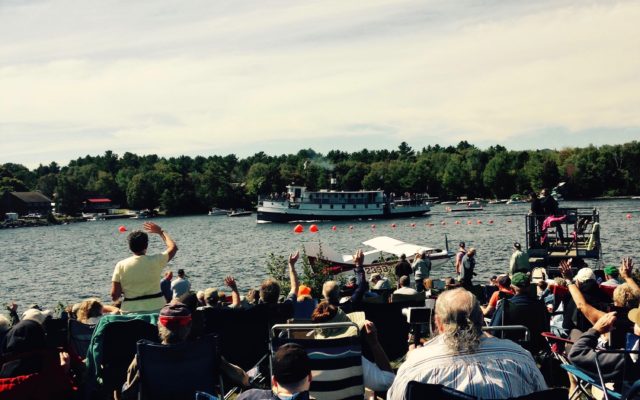
46th Moosehead Lake fly-in coming up in September
GREENVILLE — The 46th annual International Seaplane Fly-In is coming up the weekend of Sept. 5-8. It promises to be a lot of fun for participants and spectators alike. It is a time when the population of Greenville swells as folks flock to the popular event. Besides watching pilots show their skills, folks can browse an excellent craft fair as well as the local shops, stop and listen to live music and enjoy delicious fare from local restaurants.
There are all kinds of planes to see besides the regular floatplanes — Cessnas, Cubs and Beavers – and some spectacular examples of rare planes make a showing. “Those have included a traditional 1944 Grumman Goose,” according to the Fly-in website. “And, It is not unusual to see a caravan or two, as well as many classic and experimental seaplanes. The design and diversity of these beauties, combined with the knowledge of the pilots flying them, make a tremendous weekend for the flying enthusiast.”

Observer photo/Shelagh Talbot
FLYING IN TO GREENVILLE — Fly-In spectators wave at the steamship Katahdin as she sails by during last year’s Fly-In. The 46th annual International Seaplane Fly-In will be taking place in Greenville Sept. 5-8.
One of the founders of this event was Charlie Coe, an ex-fighter pilot who joined the Army Air Force when he was only 19 at the time World War II began. “They needed pilots really bad,” Coe recalled in an article penned by William Pond for The Voice of Maine. “I was interested in flying since I was a little kid. Instead of playing with toys in the sand, I built model airplanes. I learned to fly in the Steerman, a bi-plane. Later, I flew Flying Tigers and Mustangs on patrols to defend our bombers.”
Later, Coe got his instructor’s rating and found his way to legendary Moosehead Lake. All he wanted to do was fly. He went to work for the Maine Forest Service and became the state’s first water bomber.
It began when he was asked to try out a new fire-fighting aid – a large pod slung below the belly of his DeHavilland Beaver. To fill it, a pilot would fly along the surface of the lake at planing speed for about 15 seconds to fill the pod. According to an article written by Philip Kopper in the 1970s (A Moosehead Man and his Flying Machine), he was “hooking up the pod for the first trial run when a fire was reported. Without taking time for the test, he flew to Flagstaff Lake (in western Maine) and contained the blaze until a ground crew arrived to snuff out the last smoldering ashes.”
Charlie’s skill as a water bomber kept him in demand by forestry services throughout Maine and beyond.
In 1958 Coe began flying for Dick Folsom, owner of Folsom’s Air Service. The bulk of the business at that time was flying sportsmen to and from remote camps and ponds. In addition, Folsom’s pilots, which included Dick, Charlie and Telford Allen, were involved with a 200-mile fire patrol route to be flown during the summer months, as well as the occasional rescue.
Sometimes Charlie flew just for the fun of it. He told Pond about one such adventure. “We play around when we can. Like any American boy, I used to enjoy what you might call stunts, ” he chuckled. “I once took Harry Sanders III (of Sanders Store fame) up for a ride. He wasn’t airsick or anything so I did a loop. He looked okay after that so I did a snap roll, a slow roll and put her in a spin. Harry was still grinnin.’ Then I did an Immelmann Roll, that’s a half loop that flattens out again on top. Never did faze Harry!”

Photo courtesy of Moosehead Historical Society
FLY-IN FOUNDER — Charlie Coe, bush pilot, one of the founders of the International Seaplane Fly-In on Moosehead Lake.
As mentioned earlier, Charlie was one of the founders of the International Seaplane Fly-In, back in 1974. Along with David Quam, Chip Taylor, Dick Folsom, Telford Allen and Duane Lander, he helped craft the event as it is today. He once told Lynn Franklin, a writer for the Maine Sunday Telegram, that the Fly-In “is like a cowboy rodeo or a lumberjack contest except it’s seaplanes and everybody is up here to show off their airplanes and their skills.”
They had the spot landing contests and bomb droppings from the beginning, but the water skiing event was eventually canceled. It seemed like a natural addition to the contests at the time – imagine a 300-foot rope attached at one end to the low-flying plane and a water-skier skimming along the surface of the lake at the other. What could possibly go wrong?
“I towed skiers up and down the lake at 60 mph,” Charlie remembered. “I’m up in the air and they are really skiing. One skier went end-over-end 16 times I guess before he stopped!” Needless to say in this litigious 21st century, the Fly-In no longer includes water skiing events behind a plane.
Charlie died 25 years ago at the age of 71. He packed a lot of living into those seven decades. Described in the past as “short, quick and bald as a cormorant’s bill,” he was dubbed Mr. Fly-In for his love of this special Greenville event. I’d like to think he’s in his favorite Beaver, doing loops and stalls over East Cove every September, celebrating the pilots and spectators at the Fly-In.
Special thanks to the Moosehead Historical Society and Museums for information and photos.